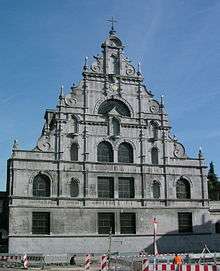Petit Granit
Petit Granit (also known by a variety of names including: Nero Belga, Granit de Flandre, Pierre Blue, Blue Stone, Belgian Granite, Belgian Blue Limestone, Arduin) is, despite its name, a grey-bluish limestone, rather than being a true Granite. It is mined exclusively in Belgium,[1] where use of the name Petit Granit is subject to an Appellation d’Origine Locale (Local Appellation of Origin) designation.[2][3] The stone becomes shiny black on polishing and is considered to be an easily worked and versatile dimension stone. It has also been used widely in sculpture and architecture, especially in Brussels and other Belgian cities.[1]
Examples
Uses
-

Sculpture: Sun bath by Michel Smolders
-

Sculpture: Crest of Liege dated 1592
-
Sculpture: The Grieving Parents by Käthe Kollwitz
-
Headstones: Cannock Chase German Military Cemetery
-
Architecture: St. Joseph Church, Frère-Orban Square, Brussels
-

Architecture: St. Michael's Church, Aachen
References
- 1 2 Pereira, Dolores; Tourneur, Francis; Bernaldez, Lorenzo; Blazquez, Garcia (June 2015). "Petit Granit: A Belgian Limestone Used in Heritage, Construction and Sculpture". Episodes Journal of International Geoscience. 38 (2): 85–90. Retrieved 12 November 2016.
- ↑ "Arrêté du Gouvernement wallon concernant l'attribution de l'appellation d'origine locale pierre bleue dite « petit granit d'âge géologique tournaisien". Wallex - Le droit wallon. Fédération Wallonie-Bruxelles. Retrieved 12 November 2016.
- ↑ "Cahier des charges type - Fédération de la Pierre Bleue de Belgique". Fédération des Carrières de Petit Granit. Retrieved 12 November 2016.

